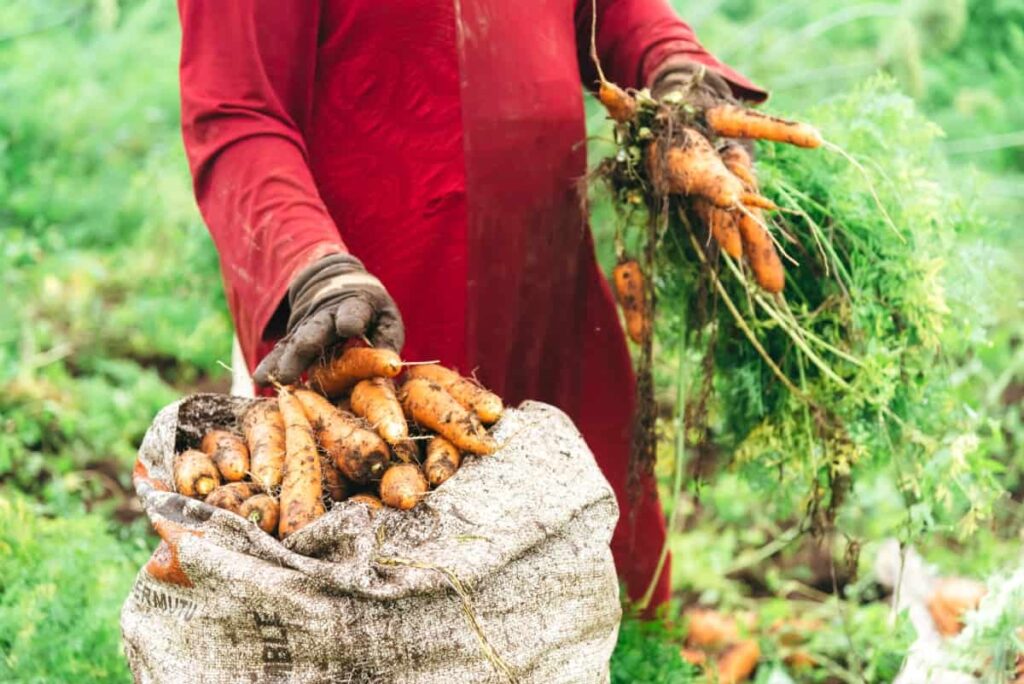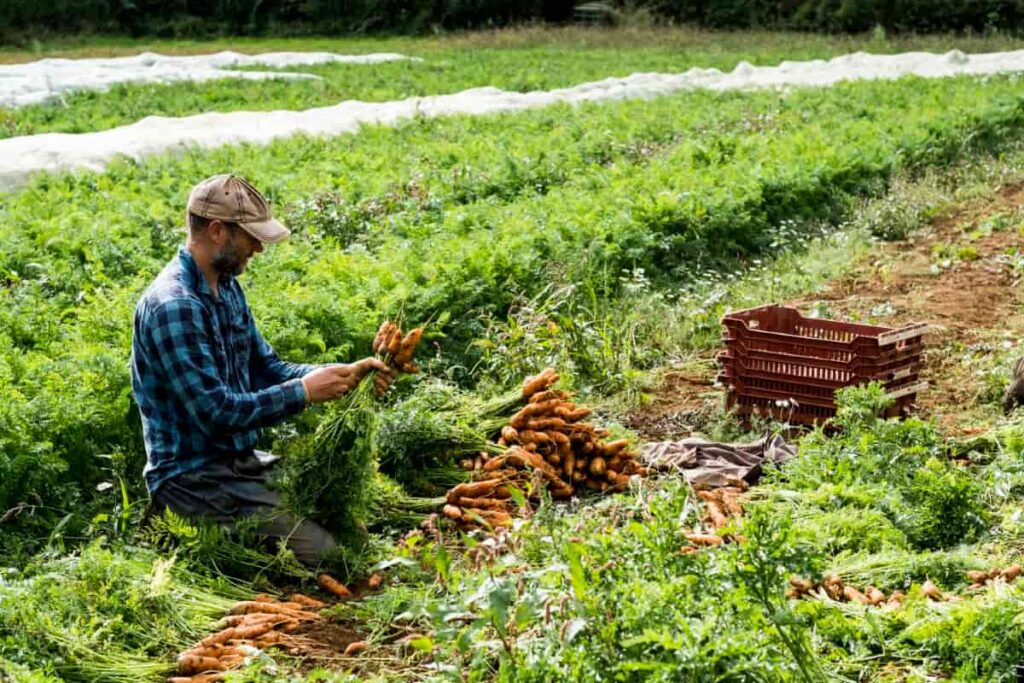Carrots, scientifically known as Daucus carota, belong to the Apiaceae family and are herbaceous plants that typically live for two years. These versatile plants are primarily cultivated for their edible taproots. Carrot farming has gained significant importance in the Philippines due to its economic potential.

Carrot Farming in the Philippines
History of Carrots in the Philippines
Carrots have a fascinating history that dates back centuries. It is widely believed that they were first cultivated in Central Asia thousands of years ago. From there, they spread to other parts of the world, including Europe, and eventually reached the Philippines. The arrival of Carrots in the Philippines can be attributed to Spanish colonization. Over time, Carrot farming techniques evolved as farmers experimented with hybrid varieties and improved cultivation methods.
Today, there are several regions in the Philippines known for producing high-quality Carrots, including Benguet province and parts of Mindanao. As consumer demand for fresh produce continues to grow, so does the opportunity for profitable Carrot farming in the Philippines.
Climate and Soil Requirements for Carrot Farming
Carrots thrive best in cool climates with temperatures ranging between 15 to 20°C, making them suitable for cultivation in highland areas of the Philippines such as Benguet and Bukidnon. The ideal soil for Carrots is well-drained, loamy soil that is rich in organic matter. Carrots prefer a pH level of 6.0 to 7.0, which indicates slightly acidic to neutral conditions.
Varieties of Carrots Suitable for Philippine Conditions
One popular Carrot variety for the Philippines is the Napoli F1 hybrid, which is known for its sweet flavor and uniform shape. Another recommended variety is Kuroda, which produces medium-sized Carrots with a deep orange color. For those looking for a longer Carrot variety, the Scarlet Nantes is an excellent choice. If you’re interested in growing baby Carrots or miniatures, consider planting Paris Market or Thumbelina varieties. Remember to select Carrot varieties based on your specific needs and preferences.
Carrot Production Areas in the Philippines
Carrots are grown in various regions of the Philippines, thanks to the favorable climatic conditions and suitable soil types. One important Carrot production area is Benguet province, called the “Salad Bowl of the Philippines.” With its cool climate and fertile slopes, Benguet produces a significant portion of the country’s Carrots.
In case you missed it: Carrot Farming Information Guide

Another key region for Carrot farming is Nueva Ecija. This province has rich alluvial soils and experiences a mild climate, making it perfect for growing high-quality Carrots. Furthermore, Laguna has emerged as an emerging hub for Carrot production. Iloilo is another prominent region where Carrots thrive.
Land Preparation for Carrot Farming
Before planting Carrots, it is important to prepare the land properly to ensure optimal growing conditions. Start by clearing the field of any existing vegetation or debris. This can be done manually or with the help of machinery such as tractors or tillers. Removing weeds and other unwanted plants will reduce competition for nutrients and sunlight.
Seed Selection and Sowing Techniques for Carrots
It’s important to choose high-quality Carrot seeds that are well-adapted to the Philippine climate. Look for varieties that have good germination rates and are resistant to common diseases. Before sowing your Carrot seeds, prepare the soil by removing any weeds or debris. To sow the seeds, create furrows in your prepared bed using a rake or hoe. The depth of these furrows should be about half an inch to one inch deep.
Gently scatter the seeds along each furrow, spacing them evenly apart. Once you’ve scattered the seeds, cover them lightly with soil and gently pat it down with your hands or a small garden tool. After sowing, water the bed gently but thoroughly to ensure proper moisture levels for germination.
Nutrient Management in Carrot Farming
Carrots have specific nutrient requirements that need to be met at different stages of their growth cycle. At the initial stage, when sowing the seeds, it is important to ensure that the soil is rich in organic matter. As the plants continue to grow, they require a balanced supply of micronutrients and macronutrients. Regular soil testing can help to find the nutrient levels present in your soil.
Pest and Disease Control in Carrot Farms
Pest and disease control is crucial in Carrot farming to ensure a healthy crop and maximize yields. One common pest in Carrot farms is the Carrot fly. To control Carrot flies, farmers can use floating row covers or erect physical barriers around their crops to prevent adult flies from laying eggs. Another troublesome pest is the aphid, which can transmit viral diseases to Carrots.
Natural predators can help keep aphid populations in check. Diseases like damping-off and powdery mildew also pose threats to Carrot crops. Proper sanitation practices, including removing infected plants and debris, can help prevent the disease spread. Crop rotation and avoiding overwatering are additional preventive measures.
Irrigation and Water Management in Carrot Farming
Carrot plants need consistent moisture throughout their growth cycle to develop properly and avoid common issues like cracking or splitting. One effective method of irrigation for Carrots is drip irrigation. Drip irrigation in Carrot farming reduces the risk of disease by keeping foliage dry. Monitoring soil moisture levels is essential in Carrot farming. It’s best to irrigate early in the morning or late in the afternoon when temperatures are cooler, reducing evaporation rates and maximizing water absorption by the plant’s roots.
Harvesting and Post-Harvest Handling of Carrots
Carrots must be harvested when they have reached their desired size and color. This usually occurs around 70-80 days after sowing. To harvest Carrots, gently loosen the soil around the base of the plants using a fork or trowel. Carefully pull out each Carrot, taking care not to break or damage them. Proper post-harvest handling is crucial for maintaining Carrot quality and prolonging shelf life.
Carrot Farming Yield in the Philippines
Carrot farming in the Philippines has shown promising yields, making it a profitable venture for farmers. The Yield of Carrots can be based on several factors like soil quality, climate, and cultivation practices. Carrot yield per acre in the Philippines is around 15 tons.
In case you missed it: Carrot Farming Business Plan: How to Grow from Seed to Harvest

Carrot Farming Cost Analysis per Acre in the Philippines
Carrot farming costs in the Philippines depend on several key factors, including market demand, input costs, weather conditions, pests/diseases, and access to markets.
| Expense Category | Estimated Cost (PHP) | Notes |
| Land Preparation Cost | 10,000 | Includes plowing, harrowing, and leveling |
| Seed Purchase | 4,000 | Cost of Carrot seeds per acre |
| Planting | 2,500 | Labor costs for planting |
| Irrigation Cost | 8,000 | Setup and operational costs for irrigation |
| Fertilizers and Pesticides | 12,000 | Cost of fertilizers and pesticides |
| Labor for Maintenance Cost | 15,000 | Regular weeding, fertilizing, and monitoring |
| Harvesting | 8,000 | Labor costs for harvesting |
| Transport and Marketing | 10,000 | Transporting produce and marketing expenses |
| Miscellaneous Cost | 3,000 | Contingency funds for unforeseen expenses |
Revenue and Profit Analysis per Acre for Carrot Farming in the Philippines
Carrot farming in the Philippines can be profitable for farmers looking to diversify their crops. The profit potential of Carrot farming largely depends on many factors like market demand, production costs, and farming practices.
| Revenue Category | Value | Notes |
| Total Yield (tons) | 15 | Estimated Yield per acre |
| Average Market Price (PHP/kg) | 20 | Estimated market price per kg |
| Gross Revenue (PHP) | 300,000 | Total revenue from sales |
- Total Profit of Carrot Farming from 1 Acre Cultivation
- Gross Revenue – Total Cost
- = 300,000 – 72,500 = 2,27,500 (PHP)
Marketing and Profitability of Carrot Farming in the Philippines
With the right strategies, you can maximize your profits and ensure a successful business. One important aspect of marketing is identifying your target market. Effective branding is another crucial element in promoting your Carrots. Regularly monitoring market trends will help you stay ahead of the competition and adjust prices accordingly. Keep an eye on consumer demands, pricing fluctuations, and any emerging opportunities for expansion or diversification within the Carrot industry.
Frequently Asked Questions (FAQ) on Carrot Farming in the Philippines
When is the Best Time to Plant Carrots in the Philippines?
Carrots thrive in cooler temperatures, so it is ideal to plant them during the cooler months of October to January. This ensures that they have enough time to grow before the heat of summer arrives.
Do Carrots Need Full Sun Exposure?
While Carrots appreciate sunlight, they also tolerate partial shade. However, full sun exposure will generally result in healthier Carrot plants and larger roots.
Can I Grow Carrots in Containers or Pots?
Yes. Choose deep containers that provide good drainage and fill them with loose potting mix enriched with organic matter.
In case you missed it: 10 Best Companion Plants for Carrots: What Not to Plant With Carrots

Conclusion
Carrot farming plays a crucial role in the Philippine agricultural industry. Carrot farming in the Philippines is a thriving industry that holds great potential for farmers. With suitable climate and soil conditions, as well as access to quality seeds and proper farming techniques, Filipino farmers have been able to grow Carrots and reap the benefits successfully.
- Sheep Farming Business Plan for Beginners
- Aquaponic Farming at Home: A Step-By-Step Guide
- Profitable Village Farming Business Ideas in 2024
- High-Yield Aquaculture: Fast-Growing Fish for Farming
- Effective Fish Pond Construction Techniques for Beginners
- Irrigation and Water Management in Pineapple Farming
- Blossom to Harvest: Mastering Flowering and Pollination in Papaya Farming
- Pig Fattening Essentials: From Selection to Sale for Beginners
- Raising Wagyu Cattle: A Complete Guide for Premium Beef Production
